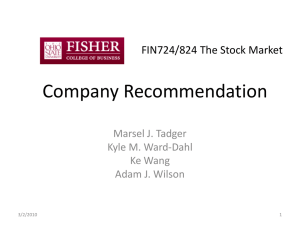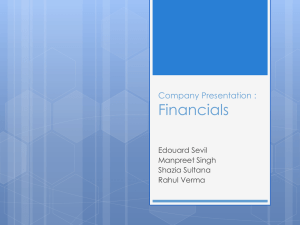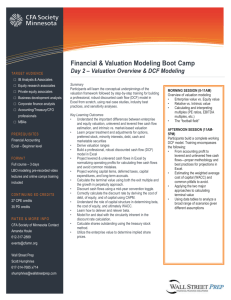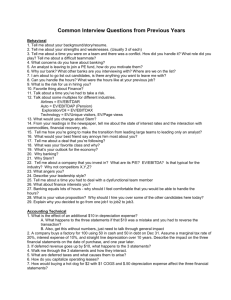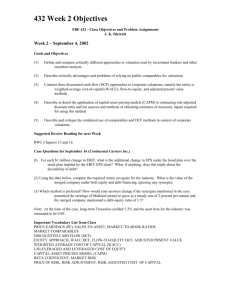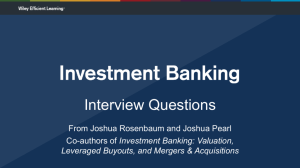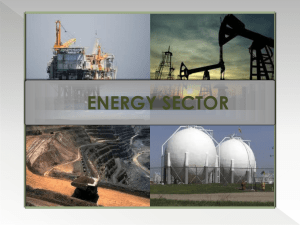Energy - Fisher College of Business
advertisement
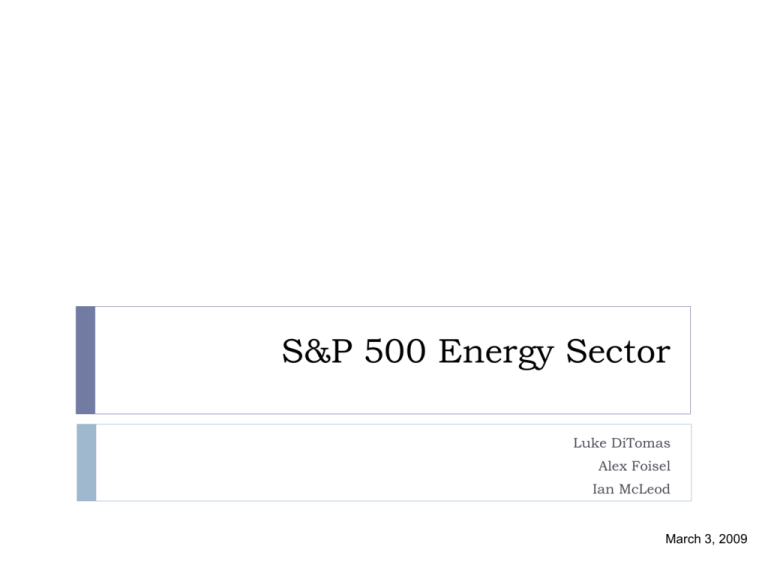
S&P 500 Energy Sector Luke DiTomas Alex Foisel Ian McLeod March 3, 2009 Agenda Review of Sector Presentation Proposal BP Pengrowth Energy Trust Transocean Technical Analysis Summary Review Sector Presentation Review Current S&P 500 Weight: 14.09% Currently underweight 604 basis points Underweight the sector by 209 basis points relative to the S&P 500 S&P 500 Weight Current SIM Weight: 8.05% An increase in current SIM Weight of 3.95% Why not underweight more? Energy prices near bottom Valuation looks very cheap Increase in global energy demand Why not overweight? Short-term demand for oil could further contract Recession could extend longer than expected Telecommunication Services, 3.72% Consumer Discretionary, 8.19% Utilities, 4.61% Materials, 3.04% Consumer Staples, 12.85% Information Technology, 16.22% Energy, 14.09% Industrials, 10.62% Health Care, 15.94% Financials, 10.72% SIM Weight Telecommunication Services, 2.19% Materials, 1.79% Utilities, 2.89% Information Technology, 18.97% Consumer Discretionary, 9.67% Consumer Staples, 14.22% Energy, 8.05% Industrials, 8.27% Health Care, 21.50% Financials, 9.59% Review Current Energy Holdings Company Market Value Current Portfolio Weight ConocoPhillips $459,405 381 bp BP $502,516 416 bp Total $961,921 797 bp Class voted to increase energy sector portfolio weight by 395 bp Review Regression: Crude Oil Prices and Energy Sector 100 90 80 70 SP-10 60 50 •Correlation: 0.9288 •R-Square: 0.8626 40 30 20 10 0 $0.00 $20.00 $40.00 $60.00 $80.00 Crude Oil Prices $100.00 $120.00 $140.00 $160.00 Proposal Proposal Company BUY SELL HOLD Resulting Portfolio Weight ConocoPhillips 0 bp 0 bp 381 bp 381 bp BP 170 bp 0 bp 416 bp 586 bp Pengrowth 75 bp 0 bp 0 bp 75 bp Transocean 150 bp 0 bp 0 bp 150 bp Total 395 bp 0 bp 797 bp 1192 bp BP British Petroleum- BP BP plc, also known as British Petroleum, is the second largest publicly traded oil company and fourth largest U.S. refiner. Headquartered in London, England, they operate in three different business segments: Exploration and Production Upstream Activities: Include oil and natural gas exploration and field development and production Midstream Activities: Include the management of crude oil and natural gas pipelines, processing and export terminals and LNG processing facilities Refining and Marketing Responsible for the supply and trading, refining, marketing and transportation of crude oil and petroleum products to wholesale and retail customers BP markets its products in more than 100 countries Other BP Alternative Energy: Segment has already had substantial businesses in solar photovoltaic, wind and gas-fired power and is developing projects in advanced biofuels and carbon capture and storage as well as new areas such as concentrated solar thermal power BP Business Analysis: BP Upsides Dividend yield- 8.78%- $3.36 per share Slight GDP growth means an increase in demand for petroleum based products .93 correlation between GDP growth and demand for petroleum based products Intends to distribute more money to shareholders through dividends rather than share repurchases BP is expected to intensify its reserve acquisitions because of depressed asset values and tight credit Balance sheet is very strong and can support growth through acquisitions EBIT Interest Expense Interest Coverage 2008 $35,239 $1,547 22.78 2007 $32,352 $1,393 23.22 2006 $35,158 $986 35.66 2005 $32,682 $874 37.39 2004 $25,746 $768 33.52 BP’s balance sheet is strong enough to withstand oil at $40-$50/bbl oil for 2-3 years Reserve replenishment ratio- 15th straight year the ratio was >100% When oil prices are low, supply begins to contract, mature projects loose marginal CAPEX meaning new growth is postponed, and EOR investments are cut Year-end reserves were: 18.2 billion barrels and a resource base of 43.4 billion barrels BP’s combined reserved and non-proved resources were sufficient for 43 years of production at the same rates as last year BP Business Analysis: BP Cont. Upsides Cont. US auto industry is bailed out or nationalized Low crude oil prices provide an opportunity to launch another wave of cost cutting and trim CAPEX- potential margin expansion in 2009 & 2010 Downsides Russia is currently experiencing policy change by the government and may cause production to fall up to 10% or 1MBD BP’s joint venture, TNK-BP may see production fall Revenue was just under $35 billion in 2008 Reserve replacement was 146% for 2008 Obama administration proposed raising at least $31.5 billion over 10 years from the oil sector as part of a fiscal 2010 budget proposal Tax benefits may be revoked which gave incentives to US refiners for hiring US workers Crude oil prices continue to fall to $20-$30/bbl and remain there through 2009 Given the before mentioned correlation of the energy sector vs. oil prices BP DuPont Analysis BP is currently outperforming both the industry and market when examining ROE Decrease in ROE can be attributed to large-scale projects which are only profitable when oil is above $70/barrel ROE ROA Profit Margin Asset Turnover Equity Muitiplier BP- 2008 Industry Median- 2008 Market Median- 2008 BP- 2007 BP- 2006 23.5% 20.4% 6.5% 22.37% 26.08% 9.3% 9.0% 0.5% 8.97% 10.24% 7.4% 3.4% 2.1% 7.33% 8.24% 1.30x 1.90x 0.60x 1.24x 1.30x 2.52x NA NA 2.49x 2.55x BP DCF Valuation- V1 The implied equity value per share is $58.02, an upside of 51.26% ($ in million) Year Forecast 2013E 2014E 2009E 2010E 2011E 2012E 365,700 281,884 -22.92% 293,191 4.01% 301,606 2.87% 310,714 3.02% 320,564 3.17% 35,239 9.64% 26,107 9.26% 27,509 9.38% 28,291 9.38% 29,145 9.38% 956 0.26% 141 0.05% 0.00% 90 0.03% Taxes Tax Rate Minority Interest 12,617 33.0% 509 8,569 33.0% 373 9,078 33.0% 472 Net Income % Growth 17,397 18,431 6% 10,985 3.00% (15,683) -4.29% 26,074 7.13% Free Cash Flow YOY growth (13,375) Terminal Value NPV of free cash flows NPV of terminal value Projected Equity Value Free Cash Flow Yield 257,428 90,335 90,662 180,997 -7.39% Revenue % Growth Operating Income Operating Margin Interest Expense and Income Interest (net) % of Sales Add Depreciation, Depletion and Amortization % of Sales Plus/(minus) Changes WC % of Sales Subtract Cap Ex Capex % of sales 2008E 2015E 2016E 2017E 2018E 331,206 3.32% 342,699 3.47% 355,105 3.62% 368,493 3.77% 382,937 3.92% 30,069 9.38% 31,067 9.38% 32,145 9.38% 33,309 9.38% 34,565 9.38% 35,920 9.38% 93 0.03% 96 0.03% 99 0.03% 103 0.03% 107 0.03% 111 0.03% 115 0.03% 9,306 33.0% 562 9,587 33.0% 668 9,891 33.0% 795 10,219 33.0% 947 10,574 33.0% 1,126 10,957 33.0% 1,340 11,370 33.0% 1,595 11,816 33.0% 1,898 19,744 7% 19,456 -1% 20,133 3% 20,877 4% 21,695 4% 22,595 4% 23,586 4% 24,679 5% 25,887 5% 10,317 3.66% 17,373 6.16% 20,098 7.13% 11,265 3.84% 9,177 3.13% 20,905 7.13% 12,138 4.02% (1,056) -0.35% 21,504 7.13% 13,071 4.21% (1,087) -0.35% 22,154 7.13% 14,069 4.39% (1,122) -0.35% 22,856 7.13% 15,139 4.57% (1,159) -0.35% 23,615 7.13% 16,289 4.75% (1,199) -0.35% 24,434 7.13% 17,526 4.94% (1,243) -0.35% 25,319 7.13% 18,858 5.12% (1,290) -0.35% 26,274 7.13% 20,295 5.30% (1,340) -0.35% 27,303 7.13% 26,023 -295% 19,282 -26% 9,033 -53% 9,962 10% 10,968 10% 12,060 10% 13,250 10% 14,550 10% 15,974 10% 17,538 10% Terminal Discount Rate = Terminal FCF Growth = Terminal 257,428.1 P/E 9.9 EV/EBITDA 5.02 Free Cash Yield 6.81% 11.0% 3.92% Shares Outstanding 50% 50% 3,119.4 Current Price $ 38.36 Implied equity value/share $ 58.02 Upside/(Downside) to DCF 51.26% *Stock Price as of February 29, 2009 close BP DCF Valuation- V2 The implied equity value per share is $50.81, an upside of 32.46% ($ in million) Year 2009E 2010E Forecast 2011E 2012E 2013E 292,955 -19.89% 300,808 2.68% 308,598 2.59% 321,872 4.30% 323,686 0.56% 52,575 41.00% 14.38% 54,152 3.00% 18.48% 56,995 5.25% 18.95% 60,985 7.00% 19.76% 66,474 9.00% 20.65% 72,988 9.80% 22.55% 35,239 9.64% 28,710 9.80% 29,479 9.80% 30,243 9.80% 31,543 9.80% 31,721 9.80% 148,494 2.8x 0.41x 178,702 3.3x 0.61x 216,582 3.8x 0.72x 256,137 4.2x 0.83x 305,778 4.6x 0.95x 372,239 5.1x 1.15x Net Income Margin 21,666 5.92% 20,038 6.84% 20,575 6.84% 21,108 6.84% 22,016 6.84% 22,140 6.84% EPS Analyst Estimates $8.17 $5.74 $4.37 $6.30 $5.97 Revenue % Growth EBITDA Growth Margin Operating Income Operating Margin Enterprise Vaule EV/EBITDA EV/Revenue Add Depreciation, Depletion and Amortization % of Sales Plus/(minus) Changes WC % of Sales Subtract Cap Ex Capex % of sales Free Cash Flow YOY growth EV/FCF 2008 365,700 10,985 3.00% (15,683) -4.29% 26,074 7.13% 10,722 3.66% 17,373 5.93% 20,888 7.13% 11,558 3.84% 9,177 3.05% 21,448 7.13% 12,419 4.02% 9,412 3.05% 22,003 7.13% 13,540 4.21% 9,817 3.05% 22,949 7.13% 14,206 4.39% 9,872 3.05% 23,079 7.13% (9,106) 27,246 -399% 6.56x 19,862 -27% 10.90x 20,937 5% 12.23x 22,424 7% 13.64x 23,140 3% 16.09x -16.31x Terminal Value Terminal Discount Rate = Terminal FCF Growth = Terminal P/E EV/EBITDA Free Cash Yield 13.0% 3.92% 264,831.7 12.0 5.22 8.74% Terminal Value NPV of free cash flows NPV of terminal value Projected Equity Value Free Cash Flow Yield 264,832 80,488 78,016 158,505 -5.75% Shares Outstanding 3,119.4 Current Price $ 38.36 Implied equity value/share $ 50.81 Upside/(Downside) to DCF 32.46% Cash Debt 8,197 33,205 51% 49% *Stock Price as of February 29, 2009 close BP Multiples Valuation The implied equity value per share is $64.67 Target multiples are 90% of 10-year mean values When compared to it sector and the market, BP is currently undervalued in nearly all multiple calculations Absolute Valuation High A. P/Forward E P/S P/B P/EBITDA P/CF P/E/G ratio ROE Stock vs. S&P500 Valuation P/Forward E P/S P/B P/EBITDA P/CF P/E/G ratio ROE High Low 1.14 1.32 1.10 1.70 1.34 2.22 1.72 B. 30.1 3.0 5.5 18.6 22.6 3.0 30.1 Mean 0.42 0.39 0.43 0.41 0.45 0.54 0.50 Low 0.63 0.64 0.83 0.75 0.68 1.30 1.19 Mean C. 8.2 0.3 1.2 2.2 3.4 0.7 9.0 Current 0.75 0.49 0.82 0.50 0.62 1.58 1.37 D. 11.5 1.0 2.7 6.4 8.5 1.8 20.0 Current #Your *Your Target Target E, S, B, Multiple etc/Share E. 9.2 0.3 1.3 2.5 4.1 1.8 19.8 F. 10.35 0.93 2.43 5.76 7.65 1.62 20.00 G. 4.17 112.82 29.51 15.34 9.36 21.31 1.94 Your Target Price (F x G) H. $43.16 $104.59 $71.70 $88.38 $71.57 $34.52 $38.75 Stock vs. Sector High Valuation P/Forward E P/S P/B P/EBITDA P/CF P/E/G ratio ROE Low 1.21 1.84 1.6 1.66 1.38 2.61 1.44 Mean 0.69 0.51 0.67 0.69 0.67 0.68 0.83 0.98 0.97 0.98 1.11 0.96 1.23 1.04 Current 0.75 0.6 0.86 0.75 0.89 1.37 0.83 BP 12-Month Price Target Calculation 12-month price target calculated based on a weighted average of: DCF v1: 20% DCF v2: 20% P/Forward EPS: 20% ROE: 20% BP plans to start at least 29 different projects in 2009, all with different hurdle rates of average crude oil prices P/EBITDA: 20% Both DCF models are trying to find the equity value of BP 12-Month Price Target: $55.82- 45.52% Upside *Upside Calculated Based off February 29, 2009 close Pengrowth Energy Trust Business Analysis: PGH One of North America's largest energy royalty trusts that acquires and manages working interests and royalty interests in oil and natural gas properties The Trust owns all of the royalty units and 91% of the common shares of the Corporation Employs over 600 people who support its operations and activities Sector: Energy Industry: Oil and Gas Equipment and Services Current Price 52-Week High $21.90 52-Week Low $4.87 Market Cap $1.24B Beta 1.09 P/E 6.31 Average Volume Shares Outstanding 254.94M $4.87 1,476,130 Pengrowth Energy Trust Business Analysis: PGH Upsides Longer term trade Growth through combination of cheap acquisitions and organic development Strong track record of meeting guidance estimates Recorded better than expected EPS numbers for Q408 and Full-Year 2008 Generates reasonably big monthly payouts to investors Revenue is easily quantifiable through stable and predictable production levels unlike traditional E&P companies Expansion of oil exploration and drilling will continue even if the price of oil does not increase further Not highly correlated with the price of oil approximately .51 Downsides Canadian government proposal to tax energy trusts could hurt future cash flows Possibly more cuts to their cash distributions (dividend payments) Recession and cash strapped economy could extend longer than expected Unattractive technical analysis Near 52-week low Broke through key support level Pengrowth Energy Trust Financial Analysis: PGH RECOMMENDATION = Buy 75bp Current Price: $4.87 Yield: 0.96 (17.00%) Target Value by DCF: $10.97 Potential Upside: 125.18% Terminal Value NPV of free cash flows NPV of terminal value Projected Equity Value Free Cash Flow Yield $ $ $ $ Shares Outstanding 1,935,954 1,982,962 681,813 2,664,775 12.70% 243,000.5 Current Price $ 4.87 Implied equity value/share $ 10.97 Upside/(Downside) to DCF Cash Debt 125.18% 6,182 Pengrowth Energy Trust Valuation Analysis: PGH The current price related ratios are all below the mean estimates and all have created new lows Pengrowth GRE: 22.0% S&P 500 and SP-10 GRE: 10.0% Pengrowth Energy Trust Valuation Analysis: PGH Revenues numbers continue to be very strong amidst this economic downturn ROE hit a bottom in mid-08 and is starting to show strength as it is starting to revert back to its mean Transocean Transocean (RIG) The world’s largest offshore drilling contractor, provides the most versatile fleet of mobile offshore drilling units to help clients find and develop oil and natural gas reserves Sector: Energy Industry: Oil and Gas Drilling & Exploration Operates 139 rigs with a presence in every major offshore market Current Price 52-Week High $163.00 Planning on building 10 new ultradeepwater units 52-Week Low $41.95 Employees approximately 21,200 employees with operations around the world Market Cap $17.55B Beta .65 P/E 4.20 Average Volume 10,865,400 Shares Outstanding 319.26M $54.98 DCF Valuation The implied equity value per share is $115.56, an upside of 110% ($ in million) Year Revenue % Growth Forecast 2009E 16,476 2010E 2011E 2012E 2013E 2014E 2015E 2016E 2017E 2018E 2019E 22,243 35.0% 30,028 35.0% 36,033 20.0% 43,240 20.0% 51,023 18.0% 60,208 18.0% 69,239 15.0% 79,625 15.0% 91,568 15.0% 105,303 15.0% Operating Income Operating Margin 3,954 24.0% 5,783 26.0% 8,408 28.0% 8,648 24.0% 9,513 22.0% 10,205 20.0% 12,042 20.0% 13,155 19.0% 14,332 18.0% 15,567 17.0% 16,849 16.0% Interest - net Interest % of Sales 247 1.5% 334 1.5% 450 1.5% 473 1.3% 497 1.1% 521 1.0% 547 0.9% 575 0.8% 604 0.8% 634 0.7% 665 0.6% Taxes Tax Rate Minority Interest 556 15.0% 872 15.0% 1,353 15.0% 1,226 15.0% 1,352 15.0% 1,549 16.0% 1,839 16.0% 2,013 16.0% 2,334 17.0% 2,539 17.0% 2,751 17.0% Net Income % Growth 3,151 4,578 45% 6,605 44% 6,949 5% 7,664 10% 8,134 6% 9,655 19% 10,568 9% 11,395 8% 12,394 9% 13,432 8% Add Depreciation/Amort % of Sales Plus/(minus) Changes WC % of Sales Subtract Cap Ex Capex % of sales 1,500 9.1% 240 1% 2,200 13.4% 2,002 9.0% (750) -3% 2,400 10.8% 2,703 9.0% (1,012) -3% 4,804 16.0% 3,243 9.0% (721) -2.0% 5,765 16.0% 3,892 9.0% (865) -2.0% 6,918 16.0% 4,592 9.0% (1,020) -2.0% 8,164 16.0% 5,419 9.0% (1,204) -2.0% 9,633 16.0% 6,231 9.0% (1,385) -2.0% 11,078 16.0% 7,166 9.0% (1,592) -2.0% 12,740 16.0% 8,241 9.0% (1,831) -2.0% 14,651 16.0% 9,477 9.0% (2,106) -2.0% 16,849 16.0% Free Cash Flow YOY growth 2,691 3,430 27.4% 3,491 1.8% 3,706 6.2% 3,772 1.8% 3,542 -6.1% 4,236 19.6% 4,336 2.4% 4,229 -2.5% 4,153 -1.8% 3,955 -4.8% Terminal Value NPV of free cash flows NPV of terminal value Projected Equity Value Free Cash Flow Yield 50,916 22,424 14,554 36,978 7% Shares Outstanding 61% 39% 320 Current Price $ 54.98 Implied equity value/share $ 115.56 Upside/(Downside) to DCF 110% Terminal P/E EV/EBITDA Free Cash Yield 50,916.04 3.79 2.44x 7.77% Multiples Valuation The implied equity value per share is $139.57 Target multiples are 90% of 5-year mean values Absolute Valuation High A. P/Forward E P/S P/B P/EBITDA P/CF P/E/G ratio ROE Stock vs. S&P500 Valuation P/Forward E P/S P/B P/EBITDA P/CF P/E/G ratio ROE High Low 5.1 6.31 1.38 2.53 2.48 2.3 2.18 B. 93.2 9.7 4.2 21.3 30.4 3.6 30.9 Mean 0.23 1.46 0.36 0.39 0.37 0.17 0.07 Low 0.63 3.62 0.95 1.4 1.46 0.32 0.47 Mean C. 3.3 1.2 0.9 2.1 2.7 0.2 1.0 Current 0.36 2.11 0.68 0.54 0.52 0.45 2.18 D. 10.9 5.5 2.7 11.8 17.4 0.4 8.3 Current #Your *Your Target Your Target E, S, B, Target Multiple etc/Share Price (F x G) E. F. G. H. 4.1 13.84 9.36 $129.49 1.4 4.92 39.55 $194.72 1.1 2.43 49.98 $121.46 2.6 10.62 21.15 $224.57 3.4 15.66 16.17 $253.23 0.5 0.36 109.96 $39.59 29.5 7.47 1.86 $13.92 Stock vs. Sector High Valuation P/Forward E P/S P/B P/EBITDA P/CF P/E/G ratio ROE Low 1.14 1.32 1.49 1.70 1.34 1.94 1.28 Mean 0.42 0.39 0.46 0.41 0.45 0.23 0.06 0.63 0.64 0.98 0.75 0.68 0.41 0.29 Current 0.75 0.49 0.73 0.50 0.62 0.39 1.23 Transocean Transocean (RIG) Upsides Downsides High oil prices support growth opportunities for RIG • Price is highly correlated with price of commodities Substantial financial flexibility from free cash flow backlog • Success is highly dependent on other integrated oil and gas companies Planning a $3+ billion share repurchase program in May 2009 • Political instability can lead to price fluctuations in crude oil and thus in RIG About a 121% larger worldwide rig fleet compared to closest competitor • Weakens with strength in US Dollar Owns the most modern and versatile fleet of rigs in the industry Majority of high specification fleets contracted into 2011 Transocean Transocean (RIG) All current values are well below the 5-year mean and very close to 5-year lows Expect the values to revert back to the mean over time Technical Analysis Technical Analysis: BP Technical Analysis Technical Analysis: RIG Technical Analysis Technical Analysis: PGH Technical Analysis Technical Analysis: COP Summary Summary Buy: BP- 170 basis points Transocean- 150 basis points Pengrowth Energy Trust- 75 basis points Hold: ConocoPhillips Appendix: ConocoPhillips vs. BP
